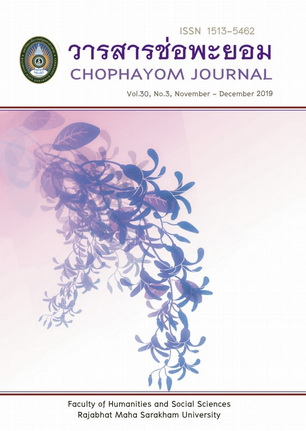Tax Administration Based on the Compliance Risk Management Principle of the International Borders in the Central Region of Lao People's Democratic Republic
Keywords:
Tax Administration, Compliance Risk Management Principle, International Border, the Central Region of Lao (PDR)Abstract
The researches objectives were to investigate the phenomena of tax administration based on the principles of compliance risk management for the international borders in the central region of Lao People’s Democratic Republic during 2557 to 2560, to design a model based on the principles of compliance risk management for tax administration of the international borders in the central region of Lao People’s Democratic Republic, and to implement and
evaluate the model for tax administration of the international borders in the central region of Lao People’s Democratic Republic. The research was divided into three phases. In the first phase, the data of the phenomena of tax administration was collected by document study and interviewing four directors and sixteen tax officers of the four international borders in the central region of Lao People’s Democratic Republic consisting of 1) Friendship Bridge 3 International Border
2) Napau International Border, 3) Friendship Bridge 2 International Border, and 4) Lao-Bao-Daensawan International Border. In the second phase, a model of tax administration based on the principles of compliance risk management was designed by twenty participants consisting of four directors and tax officers of the four international borders in the central region of Lao People’s Democratic Republic, and specialists in tax management and compliance risk management through focus group discussion and criticizing the model. In the third phase, the model was implemented with thirty tax officers of the international border of Friendship Bridge 2, Sawanakhet Province. They were selected by simple random sampling. MANOVA was employed for data analysis. The results showed that 1) the phenomena of tax administration of the international borders in the central region of Lao People’s Democratic Republic during 2557 to 2560 consisted
of 4 risks: taxpayers, resources, equipment, and results. 2) The model of tax administration based on the compliance risk management principle was a process of risk management for tax administration. An equipment was selected to suit taxpayers’ traits and current resources. These enhanced taxpayers to follow the tax law correctly, and preventing tax avoidance. The model occurs in a circle of 7 steps: 1) Identifying taxpayers for tax administration, 2) Analyzing taxpayers’
problems and causes, 3) Setting achievement goals, 4) Evaluating the equipment, 5) Implementing the equipment with taxpayers and tax officers, 6) Planning to use the equipment, and 7) Choosing the proper equipment with type of taxpayers and problems, respectively. 3) Tax administration of the International borders in the central of Lao People’s Democratic Republic, after implementing the model of tax administration based on the compliance risk management
principle, was better than that of before implementing. Keywords : Tax Administration, Compliance Risk Management Principle, International Border, the Central Region of Lao (PDR)
References
2.Economic Trade Newspaper. (2562). Lao PDR gains higher revenues but doesn’t reach target. (Retrieved January 14, 2562) from https://laoedaily.com. la/42422/01/22/2019.
3.European Union. (2010). Compliance risk management guide for tax administrations. (Retrieved November 10, 2018) from https://ec.europa.eu/taxation_customs/resources/documents/common/publications/infodocs/taxation/ riskmanagt_guide_en.pdf
4.Kerkkiat Phipatseritham. (2552). Finance in Allocation and Distribution. (1st.ed.). Bangkok: Thammasart University Press.
5.Office of Trade Promotion in International Countries. (2554). Lao PDR.: Import-Export Law. (Retrieved November 21, 2018) from https://rubber.oie.go.th.
6.Pornphan Tanmuntong. (2550). Factors Affecting Efficiency of Tax administration of Subdistrict Administration Organization, Kanchanaburi Province. Independent Study of Master degree of Politic, Khon Kaen University.
7.Revenue Department. (2556). Regulations for Registration, Testing, Licensing, Training, Licensing Renewal for Tax Service Officers. Bangkok:Revenue Department.
8.Risk Management Center. (2556). Tax Administration Based on the Compliance Risk Management. Journal of Revenue Knowledge.Vol.28 No.87 July - September 2014.
9.Sasigan Chatupha. (2557). Tax Management of The Revenue Department. Administrator Journal. 34(1), January-June, 2557.
10.Siriporn Sisawang and Sithidej Sirisukkha. (2558). Factors Affecting Efficient Tax Administration of Subdistrict Administration Organization in Thayang district, Phetburi province. Veridian E-Journal, Silpakorn University. 8(1) January – April, 2558.
11.Sirirat Wirunphan. (2553). Factors Affecting Efficiency of Subdistrict Administration Organization Revenues of Chalermphrakiet District, Burirum Province. Independent Study of Master of Public Administration: Graduate College Burirum University.
12.Supranee Hansachaktri. (2557). Guidelines for Creating Customers’ Satisfaction toward Tax Auditors on the use of New Concept of Tax Auditors:NEW TA. Journal of Sutthiparitat. (28)87, July-September.
13.Surasak Topasi and Jittraporn Suttiworaset. (2561). Efficiency of Tax Administration of Bangsaothong municipality, Samutprakan province. Academic Journal, Sripathum University. 10(2), (January-December, 2561) (Retrieved November 10, 2560) from file:///C:/Users/Advice/ Downloads 177551-Article%20Text-505448-1- 10-20190313% 20(1).pdf
14.Soyphet Lisni. (2557). Factors Affecting Efficiency of Tax Management: In Case Office of Revenue, Region 6. Academic Journal of Association of Thai Private Higher Education Institute. 20(2): 2557
15.Wijit Awakun. (2550). Training. Bangkok:Chulalongkorn University Book Center.
16.Yamane, Taro. (1973). Statistics: An Introductory Analysis. 3rd ed.New York: Harper & Row Publisher.






